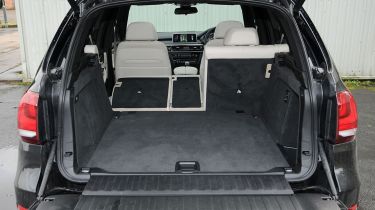Used BMW X5 (Mk3, 2013-2018) review - How practical is it?
The BMW X5 Mk3 has a spacious interior and a roomy boot, but luggage capacity shrinks quite a bit on plug-in hybrid models
Because the BMW M5 Mk3 is pretty big even by class standards, it’s a handily practical car for families. There’s lots of space inside for passengers, and the boot space is pretty big on all models apart from the hybrids, due to the way the battery pack is positioned. Equipment levels across the board are good, too, even though a lot of features were only available as optional extras.
Dimensions and cabin design
Size-wise, the BMW X5 Mk3 is a pretty big car, being 1,933m long and 1,776mm tall. It’s also 4,857mm long, which means the BMW is a bit longer than some of its rivals like the Porsche Cayenne, Mercedes GLE and Range Rover Sport.
Those grand dimensions do translate into the BMW X5 Mk3 being a pretty practical car. On five-seater models, there’s plenty of head room on offer, and features like the flat floor mean there’s lots of leg room available for rear seat passengers. Because the BMW is so wide, it means even adults can get comfortable in the rear seats.
On seven-seater models, the two back seats aren’t quite as practical. While head room is still decent, there isn’t much leg room on offer here. As a result, these two rear seats on seven-seater models are only really suitable for children.
Used - available now
In contrast with the roomy cabin, the storage spaces on the BMW X5 Mk3 aren’t quite as impressive, though there are sufficient numbers of pockets, cubby holes and sizeable door bins to store odds and ends in.
Boot space
On five-seater models, the BMW X5 has up to 650 litres of boot space with all rear seats in place, and up to 1,870 litres with the rear row folded down. While this is a bit down on what the most spacious cars in this segment can manage (with the rear seats up and down respectively, a Mercedes M-Class has up to 690 litres and 2,010 litres), it should still be plenty for families.
BMW never quoted boot capacity figures for the seven-seater models with all the seats in place, but the space does shrink considerably if you need to carry seven people. Do also bear in mind that, due to the way the battery pack has been packaged, the boot space on the plug-in hybrid version shrinks from 650 litres to 500 litres.
Even though the boot space can vary depending on the model, all BMW X5 Mk3 variants get a split-folding tailgate as standard, which helps create a flat lip that makes loading and unloading heavy items in and out of the boot easier. It’s handy, too, that the boot opening is large and the seats lie down completely flat with the floor when they’re folded down.
Equipment and technology
When new, the BMW X5 Mk3 was available in two main trim levels: the entry-level SE spec and the slightly sportier M Sport trim. While it was the lowest rung of the X5 spec ladder, the SE grade was quite well equipped, with cruise control, two-zone climate control, a 10.2-inch infotainment screen with built-in navigation. Power-adjustable front seats were also standard features, albeit only on the all-wheel-drive models.
Upgrading to the M Sport spec doesn’t add many noteworthy extras – the new item with the biggest impact would be the adaptive suspension, which allows the driver to set the car up to be more oriented to handling or comfort. They also get sports seats that have more bolstering than the seats on the standard car, as well as a mildly more aggressive bodykit.
Being a premium car, the BMW X5 Mk3 was available from new with a large number of optional extras – ranging from heated front seats and LED headlights, to a reversing camera and a panoramic sunroof. This means checking the specs of the car you’re looking at is important, as the equipment levels can vary considerably depending on what options were specified from new.
Safety
The BMW X5 Mk3 was never given a safety rating by Euro NCAP, because it was never assessed. However, its safety credentials should be good, as the X5 Mk3 came with a fairly comprehensive array of safety equipment. All cars came as standard with a complement of airbags, traction control, braking assists and a cruise control system that also has an automatic braking feature if an imminent collision is detected. Examples of other safety features that were available on the X5 Mk3 included automatic headlights and a tyre pressure monitoring system.
If you’re specifically looking at seven-seater versions of the BMW X5 Mk3, do bear in mind there weren’t any airbags for the third row of seats.











